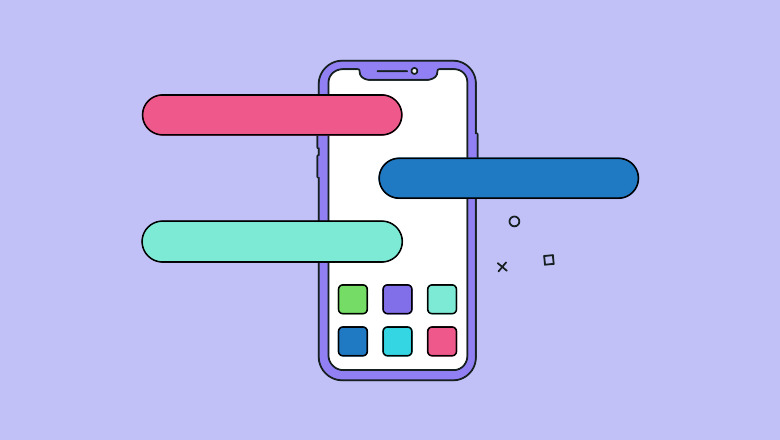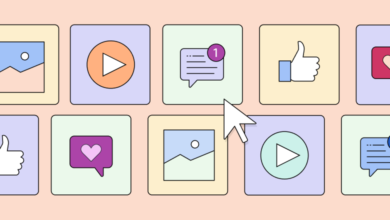11 Social messaging apps every marketer should know in 2022
Social media messaging is an integral part of daily life for most of us.
Today, 70% of people agree they expect to have conversational experiences with brands on social media, too. But finding ways to talk directly to your consumers can seem intimidating. So, how can you integrate conversational marketing into your strategy? Enter: social media messaging apps.
Social messaging apps give marketers the opportunity to connect with people one-on-one by creating impactful, personalized touchpoints. These channels are approachable for consumers, social media managers and customer care specialists alike.
When choosing the right apps to talk to your audience, consider why and how people want to connect with your brand.
- Do they want a quick response to a frequently asked question?
- Are they looking for a video consultation with an expert before buying?
- Do they need help using your product or service?
In this guide, we’ll break down the 11 most popular social messaging apps and their use cases. From the well-known to the often overlooked, we’ll help you find the right app(s) to reach your community.
Why should your brand use social messaging apps?
The customer journey is changing. Social media is now an essential part of reaching people, from generating awareness to creating advocacy. Consumers expect to direct message, voice chat or video call your brand when they’re in a moment of need. Social media messaging apps allow you to meet consumers’ new communication expectations while supporting your business objectives.
Engage in conversational commerce
About 90% of consumers buy from a brand if they follow them on social. That impressive number reveals how important it is to invest in your social messaging strategy. When brands adopt conversational commerce tools like chatbots, live chat and video consultations, they deliver easier buying experiences and win more sales.

Provide customer service and care
People will no longer settle for one-way communication or outdated 1-800 numbers when dealing with a customer service issue. They expect brands to use the most convenient channels for them, including social messaging apps.
If you’re not available to support your customers with social messaging, you will leave gaps in the customer experience. Some 67% of consumers identify responsive customer service as the most important factor in creating a positive experience with a brand on social.
Build a pool of brand evangelists
Be attentive and engage thoughtfully when people send you a positive direct message. By providing an extra level of care, you will make them feel like a top priority, and more likely to become a loyal customer.

Take it a step further by surprising some of your diehard admirers with V.I.P. discount codes, premium offers, access to exclusive live events and sneak previews. These extra steps will turn your customers into brand advocates.
Navigate a social media crisis
On the flip side, show just as much care and attention when things go wrong. Although you can’t always control a social media crisis, you can minimize its negative impact by addressing customer concerns via social messaging apps. Keep a keen eye on your notifications and @mentions to prevent negative feedback from snowballing.
Thankfully, this doesn’t mean monitoring your social feeds 24/7. Social media engagement tools like Sprout Social can notify you of engagement spikes and spot a potential crisis before it snowballs.
11 most popular social messaging apps
Now, let’s dive into the most frequently used social media chat apps.
- Instagram direct messages
- Messenger
- TikTok direct messages
- SnapChat
- Telegram
- Discord
- Viber
- Twitter direct messages
- Zendesk
1. WhatsApp
Monthly active users: 2 billion
Key benefits:
- Chatbots
- Video and voice chat
- No ads
- Businesses can send 6 different message types
The growing buzz around WhatsApp has many marketers asking, “What’s up with WhatsApp?” As the most popular messaging app in the world, WhatsApp is proving to be an essential part of modern marketing and customer care strategies—especially for brands with a global audience. WhatsApp makes it possible to streamline all messaging with consumers in one convenient place. Whether they have an issue with their order or are looking to buy something new, WhatsApp is the channel people turn to.

On WhatsApp, you can call, video call or live chat with customers. If you face a high quantity of messages, you can also employ chatbots on the app. Although the app doesn’t allow advertising, brands have other opportunities to effectively reach consumers. For example, some leading brands use digital catalogs to help their customers discover their products and services.
2. Instagram direct messages
Instagram monthly active users: 2 billion
Key benefits:
- Integrated with Instagram
- Built-in GIF and sticker gallery
- You can add filters, effects and drawing to images
- Video and voice chat
Instagram is the most downloaded app in the world. Instagram direct messages (DMs) play an important role in its success by allowing users to connect one-on-one and in group messages. In the Instagram app, you can send DMs to all users, including brands.
Instagram DMs are a great way to dip your toe into social messaging apps. Chances are if you have a presence on Instagram, you’re already familiar with DMs, as they don’t require a separate app or account. Even when a consumer tags your brand in their Stories, you’ll automatically see it in your DMs.
Instagram DMs have built-in GIF and sticker galleries so you can infuse whimsy into your messages. If you send a photo or video, you can also add filters, effects and drawings. As Instagram continues to evolve into a video-first app, you can now make video calls and voice chat in DMs, too.
3. Messenger
Monthly active users: 1.3 billion
Key benefits:
- Integrated with Facebook
- Automated replies and chatbots
- Built-in GIF and sticker library
- Video chat
Messenger is Meta’s most-used feature. Originally launched in 2011, the app is separate from the Facebook platform, but still integrated in the user interface. Well-known around the world, Messenger is the right app for brands trying to reach a wide variety of people.
When using Messenger for business, you can create automatic replies and set up chatbots to answer frequently asked questions. This is useful for brands who receive a high volume of incoming messages.
Like Instagram, the app offers a built-in GIF and sticker gallery so you can infuse personality and playfulness into your live-chat, too. If your customer care cases go beyond chat, Messenger also provides video call capabilities.
4. TikTok direct messages
TikTok monthly active users: 1 billion
Key benefits:
- Integrated with TikTok
- Custom auto-replies
Like Instagram, TikTok messaging is integrated in the app. With 1 billion monthly active users and growing, the potential for reaching people increases everyday. But TikTok messaging is unique. To send a message, the recipient must accept your message request—even if they’re a brand.

For some consumers, this feature adds a roadblock on their customer journey. But this extra step also prevents your inbox from overflowing—which makes it easier to prioritize ongoing conversations with brand advocates, influential creators and high priority customers.
TikTok also offers an automated response option for business accounts. This helpful workaround allows you to acknowledge people sending you messages before accepting. It also enables you to answer frequently asked questions based on common keywords.
5. WeChat
Monthly active users: 1 billion
Key benefits:
- Reaches Chinese-speaking communities worldwide
- Video and voice chat
- Broadcast messaging
- Social commerce capabilities
If you’re trying to reach Chinese-speaking communities, WeChat is a must-use app. Facing steep competition, WeChat emerged as the leading Chinese messaging app because of its high message capacity and social commerce capabilities. In fact, users can send up to 45 billion messages a day. They can also send voice chats and make video calls. Like other social media platforms, they can broadcast messages publicly on WeChat, too.
WeChat’s social commerce integrations are among the best in the mobile payment app industry. WeChat Pay boasts 900 million users who send money and make purchases within the app.
For global brands, WeChat should play a pivotal role in their strategy—especially for timely events like Lunar New Year celebrations.
6. Snapchat
Monthly active users: 500 million
Key benefits:
- Disappearing images and videos
- Custom filters, effects and drawings
With certain social messaging apps, success depends on cross-promotion with other platforms. Take Snapchat for example. For people to see your content, they must subscribe to your Profile. To spark intrigue, share snippets of the highly engaging videos you’re posting on Snapchat to other social apps. This might include behind-the-scenes tours, interactive custom filters or influencer takeovers. You can also include links to your website or app in your content.

Once you amass a following and your Profile is verified, you can start having meaningful conversations around the Stories you post. For example, your subscribers can send you questions or share their love for your new product. You can also Quote your followers’ replies and share them on your Story—this level of engagement is key to creating loyal superfans.
7. Telegram
Monthly active users: 500 million
Key benefits:
- Edit and delete messages after you send them
- Location sharing
- Expiring messages
- Unique themes and stickers
- Supports group messaging up to 200,000 people
Similar to WhatsApp, Telegram is a popular alternative to traditional SMS texting—particularly for people messaging between countries. Telegram enables large group messages, location sharing and unique themes and stickers. But it also has additional features popular for businesses, including B2B brands.
In Telegram, you can edit and delete messages after they’ve been sent, or set an expiration date on a message. This could be valuable when you need to send a customer an expiring code or if you’re a B2B business sending confidential paperwork.
8. Discord
Monthly active users: 350 million
Key benefits:
- Video and voice chat
- Screen sharing
- Bottom of the funnel opportunities
- Live events
Discord, the social messaging app used most frequently by gamers, is a new frontier for many companies—even retail brands are beginning to tap into the platform’s potential.
By creating a Discord server, you are able to add channels catering to the niche interests of your community. Your channels can be private, public or view-only.

In your server, you can host live events. Whether it’s an “ask me anything” video or a gaming tournament, live events encourage advocacy and conversation within your community. Leading brands on Discord also give their consumers access to premium channels to encourage repeat purchases.
9. Viber
Monthly active users: 250 million
Key benefits:
- Built-in GIF and sticker gallery
- Video chat
- Built-in QR code scanner
- Supports unlimited group messaging
Viber, or Rakuten Viber, is another social messaging app often preferred over traditional SMS texting, especially in eastern European and Middle Eastern countries. Known for its security and end-to-end encryption, it’s marketed as one of the safest messaging apps. Viber offers group messaging with no size limitations, video chat and a built-in GIF and sticker gallery. Users with a subscription plan can also make calls to all telephone numbers.
Viber for Business allows companies to chat with customers through its platform, but this feature isn’t available in many countries. However, all brands can create ads for the app and take advantage of the built-in QR scanner.
10. Twitter direct messages
Twitter monthly active users: 217 million
Key benefits:
- Integrated with Twitter
- Chatbots
- Built-in GIF and sticker gallery
If your brand is on Twitter, you probably already use your Twitter DMs to communicate with customers. Twitter DMs are integrated into Twitter, and anyone can send other users messages. In your DMs, you can employ chatbots to provide exceptional customer care, too.

We recommend using the built-in GIFs, sticker gallery and emojis to infuse your brand’s identity into your conversations.
11. Zendesk
Key benefits:
- Omnichannel customer care
- Voice chat
- Chatbots
Although not technically a social messaging app, Zendesk is the glue that holds an effective social messaging strategy together. Zendesk is a customer service software dedicated to helping brands create meaningful, personal and productive relationships with their customers.
The software integrates with your social messaging apps to provide customer support and sales outreach at scale. You can also connect Zendesk with a social media management platform like Sprout Social to resolve issues faster across your social and customer service teams.
Manage your social messaging apps in one place with Sprout Social
If these social messaging apps are already a part of your strategy, you know the struggle of trying to balance so many channels at once. Sprout Social’s Smart Inbox unifies your social channels into a single stream to monitor all incoming messages. It simplifies customer care and outreach by making it easy to see messages, mentions and brand keyword usages at a glance.

The Smart Inbox offers tools like People View to help you provide personalized experiences for your contacts. In People View, you can foster connections with influencers, manage your VIP Lists and view conversation history with a specific user profile.
It all boils down to this: When using social messaging apps, you must make your customers feel like they’re your top priority.
Looking for more guidance to help you refine your social messaging strategy? Learn why social messaging is the future of the customer experience.
The post 11 Social messaging apps every marketer should know in 2022 appeared first on Sprout Social.






